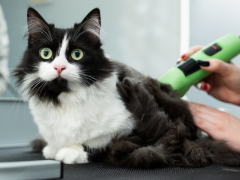
Your cat might not be as exuberantly social as the neighbor’s Golden Retriever, but that doesn’t mean your feline friend isn’t capable of love, affection, loyalty, and everything else that comes with a strong friendship.
Cats are domestic pets, and many of them thrive when they feel a strong connection with at least one family member. There are several emotional and physical benefits associated with having a strong bond with a cat, and taking the time to nourish and maintain that relationship will always be worth the effort.
Like people, no two cats are the same. There are countless factors that go into your relationship with your cat including their personality, your personality, your home life, and even your cat’s health. You’ll need to get to know your cat on a deeper level to form a truly strong bond, but there are several things you can do to get started.
Here are a few tips that might seem unconventional at first, but they can really help strengthen your bond with your cat.
1. Respect Your Cat’s Personal Space and Boundaries
Imagine someone coming up to you while you’re relaxing, eating, or simply minding your own business and forcing an interaction. They might try to take you away from whatever you’re currently doing or put body parts uncomfortably close to you. It doesn’t matter how you feel about this person on a normal basis; no one likes being disturbed or distracted when they’re not in the mood. It’s important to remember that your cat feels the same way.
Your cat might love you and often seek attention, but that doesn’t mean she wants your face inches from hers while she’s trying to nap. She doesn’t want you to pick her up while she’s comfortably making biscuits just because you want her in your lap.
It can be hard to resist, but you need to remember that your cat has her own opinions and boundaries.
When you disregard those feelings, you show your cat that you don’t respect her or care about her feelings. Routinely popping her personal space bubble will create a rift in your relationship.
Leaving your cat alone might seem counterproductive when trying to strengthen your friendship, but respecting your cat’s boundaries will help you stay on her good side and show her how much you care about her feelings and opinions.
2. Offer Your Cat Choices
Your cat might act like she rules over the entire house, but the truth is that cats have very little say in what happens to them. They’re completely reliant on human family members when it comes to the essentials like food and water. They also can’t control how people behave or spend their time, even when it affects their own well-being.
Cats are at the mercy of your schedule, your feelings, and your behaviors every second of every day. That kind of powerlessness is understandably stressful. You don’t want your cat to associate you and your relationship with feelings of helplessness and restrictions.
It’s unrealistic to give your cat complete control over their environment. That includes the people and objects around them. You can, however, give them strategic opportunities to make choices for themselves. Having multiple cat beds, for example, isn’t excessive.
It’s giving your cat the freedom of choice. You can also give your cat the choice of who they want to interact with. If your friend’s toddler comes to visit and wants to pet the cat, don’t force your cat to tolerate the attention if she doesn’t want to. Give her the option of playing or leaving the room.
3. Be Predictable

You can help your cat feel more confident by keeping to a consistent routine.
Spontaneity has its place, but not when it comes to the relationship with your cat. It relates back to that lack of control. Cats have no say in when you go to bed or when the house is flooded with kids on the weekends. It can be stressful, but you can help your cat feel more confident by keeping to a consistent routine.
This strategy relates to both the activities that directly affect your cat and those that don’t. For example, you should fill the food bowl around the same time every day and clean the litter on a predictable schedule.
Some cats are more easy-going and won’t care what the rest of the family is up to. For shy cats, however, you can help your bond by being a steady and reliable part of their life. It’ll help your cat if you come and go at generally the same times and give them attention on a predictable basis. Of course, there will be days when you can’t help but switch things up. When this happens, show your cat extra compassion and patience.
4. Become Fluent in Feline Body Language
Communication is an important part of the feline/human relationship. You and your cat don’t speak the same language, but that doesn’t mean you can’t learn to interpret important messages. You can do this by taking a few key lessons in feline body language.
When you’re fluent in feline body language, you can interpret a quick tail-flick or ear twitch to tell you what your best cat friend is thinking. Some body language is easy to decipher. When your cat’s fur puffs up and they hiss, they’re feeling afraid. Other body movements, however, are a little tricker.
Don’t be fooled, for example, by a wagging cat tail. Cats aren’t like dogs. A moving tail often indicates irritation, not joy. At the same time, an exposed cat belly might not be asking for belly rubs. Your cat is probably saying she trusts you. Betraying that confidence by rubbing their sensitive belly could set your relationship back a few steps.
5. Train Your Cat

You can train your cat just like you would a dog; repeat their name and give treats and praise when they respond.
Most people assume you can only train dogs and not cats. That kind of thinking, however, underestimates a cat’s willingness to learn and interact with humans. Training a cat might take more patience than training a dog, but many cats easily learn simple behaviors and tricks.
You’ll need to be consistent, but regular training sessions using positive reinforcement are a great way to strengthen your bond with your cat.
Not only will you spend one-on-one time together, you also help your cat associate you with treats and praise. By rewarding your cat on a regular basis, you show her you are a positive and trustworthy part of her life. The mental stimulation will also keep your cat happy and more willing to offer companionship.
To start training, try teaching simple behaviors like sit and coming when called. You can eventually move up to walking on a leash, which will provide even more opportunities to bond.
While cats don’t hold grudges, it’s a lot easier to form a bond when you start from a place of mutual trust and respect. Before you worry about strengthening your bond, take time to ensure you have a solid foundation of trust.
Get to know your cat’s personality and don’t expect her to fall in love with you overnight. Remember that cats are complicated creatures, but you’ll never regret making the time and effort to strengthen your relationship.
Also Read: How To Train Your Cat Not To Bite?








This is a really great article! Thank you for making it. It’s really interesting!
My current cat doesn’t really like treats. I’ve tried a lot of different ones. The only thing I’ve found that resembles a treat is finely shredded cheddar cheese. Since cats are lactose intolerant I only give him a few small pieces. But I still can’t seem to use it as a training aid, since he doesn’t seem to want to eat from my hand.
One thing I’ve learned and is kind of fun with all my cats I’ve had is to combine training and communication. Once you have basic trust and you have a little bit of communication going on, I’ve found that you can train your cat to communicate with you. You can keep building on it more and more. It generally results in a very happy cat. I don’t know if anyone else has had this experience, but I mean you can kind of make things up. Surprisingly, cats seem to understand pointing and pointing arm motions really well; as an example. Sometimes it takes them a little time to figure it out, but they seem to pick up on what you are doing/saying pretty quick. Since human and cats are such different species it’s pretty surprising that they pick up on that as well as they do. Then again, cats communicate with other cats with body language to a great degree, so when you take that into account, it’s not so surprising, and once you realize that, it makes communicating with them much easier.
Thanks for sharing your experience and observations! Also, I recognize your username from YouTube—great to see you here! 🙂
– Mallory
Very interesting. I thought I knew a lot, but you showed me I still need to learn about cat behavior and also how to read their body language. Thanks
I find your articles very interesting as I have a cat named Nicholas who was diagnosed with inflammatory bowel disease nearly a year ago. The vet could only diagnosis it through surgery and a biopsy. Nicky went from a very healthy feline to one that must be medicated daily and be on a prescription diet. We are best buddies but medication time is dreadful. I have autoimmune disease also so I think it is pretty cruel that Nicky has one also. Thanks for your insight into the world of cats. They are unique animals.
Wow, this article was so informative! Most of these things I do with my cat but I learned a few new ways to deepen our human-feline bond! I also wanted to share another way that I bond with my kitty. My Moonpie loves to go out into our privacy fenced in backyard. In the morning, when I first let him out, I go out there with him. I give him fresh outdoor water, then the both of us proceed to “explore” the backyard together. I walk around checking things out, and he follows me. When he zeroes in on a certain smell or sight, I go over to where he is become very interested in what he is focusing on. We do this about four times a week for about 15 minutes. We both enjoy it so much.
Thank you Doctor for all your wonderful advice!